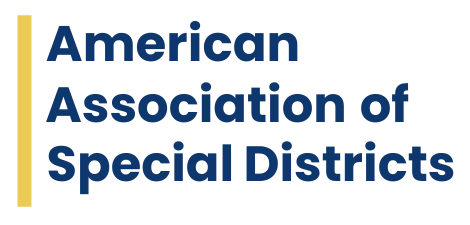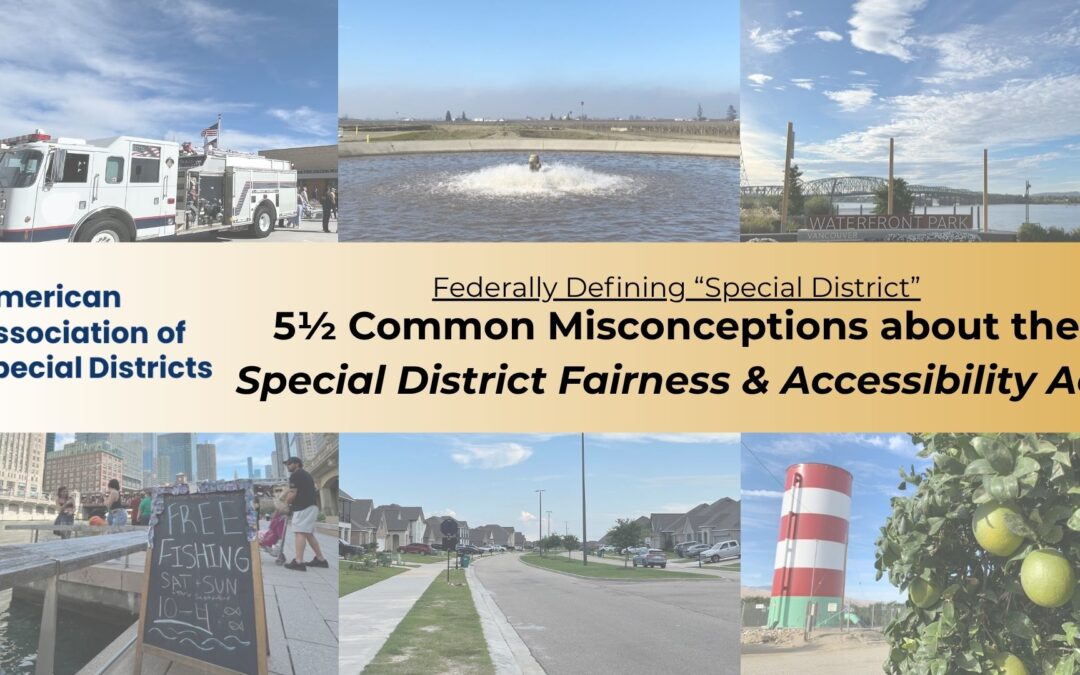Special districts have historically been at a disadvantage to engage with and participate in a wide range of federally-sourced programs. This long-standing public policy issue is complex and is largely rooted in the lack of a single definition of what a “special district” is as a unit of government.
Since 2020, special district advocates have been pushing to establish a formal federal definition for “special district” that generally captures the essence of the special purpose structure of local government. This, after the federal pandemic relief and recovery programs intended for state and local governments exposed major, widespread misunderstandings of districts as independent agencies providing public infrastructure and essential services.
In the current 119th Congress, this bipartisan effort continues as the Special District Fairness and Accessibility Act.
The lack of a “special district” definition also impacts federal recognition of special districts’ service to people. Under current law, special districts are not considered geographic units of government, which prevents agencies from certifying special districts’ socioeconomic and other demographic figures that are otherwise available to towns, cities, counties, and school districts. This thwarts special districts from directly accessing population-based funding opportunities and creates a major hurdle to apply for a range of grant and finance opportunities.
This significant policy matter unites all special districts – no matter the type of public service they provide, and is why the American Association of Special Districts strongly supports H.R. 2766 (Fallon), the Special District Fairness and Accessibility Act, and considers it the simple solution to the No. 1 federal policy issue facing America’s special districts.
What is the Special District Fairness and Accessibility Act?
The bipartisan Special District Fairness and Accessibility Act that would codify a definition, thus setting a statutory basis for recognition of special districts as units of local government.
The bill would define “special district” as a political subdivision of a State, with specified boundaries and significant budgetary autonomy or control, created by or pursuant to the laws of the State, for the purpose of performing limited and specific governmental or proprietary functions that distinguish it as a significantly separate entity from the administrative governance structure of any other form of local government unit within a State.
Finally, the bill would require the Office of Management and Budget to direct federal agencies to adopt the definition for the purposes of their programs, clarifying that districts are actually local governments that may be eligible for programs that towns, cities, and counties can otherwise access.
All in all, the Special District Fairness and Accessibility Act would set special districts on a more level playing field to engage with federal programs – whether it is grants and finance or involvement in federally-backed infrastructure projects.
H.R. 2766, the Special District Fairness and Accessibility Act, is the second post-pandemic era attempt at a definition. Identical efforts in the 118th Congress demonstrated strong bipartisan support for the effort, earning 352-27 approval in the U.S. House and 10-1 support in the Senate Homeland Security & Governmental Affairs Committee.
What is the opposition to placing special districts on a level playing field?
Through follow up discussions and constituent engagements with federal representatives who have previously voted against the proposal, the American Association of Special Districts has identified 5½ common misconceptions that have led to opposition of the Special District Fairness and Accessibility Act – all of which could be smoothed over with more education and awareness of special district fundamentals.
AASD debunks the five-and-a-half, myth-like misunderstandings that fuel opposition to the bill.
Misconception 1: The Special District Fairness and Accessibility Act would infringe on states’ rights.
Those who have previously opposed or expressed concern over the bill have cited hesitation over the federal government intervening in what states have set up for their own local government structured.
In other words, this misunderstanding is that a federal definition would force states to comply with the federal view of a special district.
However, that is not the case. The “special district” definition was crafted to provide a formal benchmark broadly capturing common elements of special districts, as political subdivisions of their states. This concern is tampered with the use of “political subdivision of a state” in the definition, which affords deference to all states and territories in how special districts are authorized in their states. Finally, the bill specifically outlines the use of the definition as a directive to federal agencies for the purposes of federal programs.
Misconception 2: This bill allocates more federal money to local governments.
Opponents and skeptics of the bill are principally against appropriating more federal dollars to support local government services. Accordingly, their common concern is that H.R. 2766 would increase federal funding to local government services.
In reality, there is nothing in the text of the legislation that authorizes funding for any existing or new program. The Special District Fairness and Accessibility Act is a matter of policy fairness and access to federal programs that Congress has already authorized and appropriated for local services.
Misconception 3: Disney World in Florida is a special district.
The 2022 Florida Parental Rights in Education law was the focus of criticism on social policy issues in the state’s elementary and secondary education system – and it had no bearing, itself, on special district services.
The Walt Disney Company, a major driver of the Florida tourism economy and third-largest employer in the state, was a high profile organization voicing criticism of the proposal as it was moving through the state’s legislature.
Where do special districts come into play? The Reedy Creek Improvement District was established by a special act of the Florida legislature in 1967 – prior to Florida’s 1968 constitutional revision. The District developed the facilities and infrastructure that Disney World utilizes, possessed the public debt for financing development, and continued to oversee critical infrastructure services such as water distribution, flood control, and fire protection.
Reedy Creek did not re-charter after the state’s revision, as it should have; thus, the district was among a handful caught in the mix. As a result, the Florida Legislature had the power to meddle with the structure of the improvement district, and Florida Governor Ron DeSantis signed legislation to dissolve the Reedy Creek Improvement District. The Central Florida Tourism Oversight District was established in 2023 to replace Reedy Creek, and the new district continues to provide many of the same services to 24 landowners on 25,000 acres in Orange and Osceola counties.
Disney World is part of a California-based private enterprise, and never has nor never will be a special purpose public entity.
Misconception 4: Federally defining special districts would foster the creation of more government.
The Special District Fairness and Accessibility Act does not authorize the establishment of additional public services. The bill is simply aimed to foster recognition of special districts as local governments.
The bill neither directs nor incentivizes the establishment of new special districts. This is because states are responsible for their own local government structures. AASD believes anything contrary would be unconstitutional, as addressed in debunking of states’ rights concerns above.
Leading advocates for the Special District Fairness and Accessibility Act cannot pinpoint the source or basis for this concern.
Misconception 5: This bill would open the door for federal funding to promote public welfare programs
Members of Congress seeking major reforms to national social services and support programs, such as the Supplemental Nutrition for Needy Families (formerly known as food stamps) or Medicaid, have voiced concern about the “welfare” classification some special districts receive in the U.S. Census Bureau’s semi-decennial Census of Governments.
Diving into this issue a bit further, we see how the voluntary nature of the Census of Governments survey and limited federal understanding of special districts combine to make this misunderstanding, as many of the 74 districts federally listed as providing “welfare” services are public hospital and healthcare providers in their communities.
With rare and limited exception, special districts do not administer welfare programs. The Special District Fairness and Accessibility Act would not change that. In fact, AASD sees the definition as an opportunity to begin clarifying this and other related misconception.
Misconception 5.5: The Census Bureau is flawed, and so is the Special District Fairness and Accessibility Act.
Yes, the Census Bureau is flawed but not in the way that reasonably fosters opposition to the legislation. In fact, the U.S. Census Bureau recognizes that the Census of Government program struggles with the lack of a statutory definition to understand what special districts are, with low voluntary response rates further deepening the issue. Census officials have told district advocates many times that a statutory definition would be significant to make their surveys and programs more efficient and accurate.
For that reason, the half of this misconception is that the bill is flawed as a result. In reality, the Special District Fairness and Accessibility Act serves to improve the recognition and understanding of special districts across all federal agencies, including but certainly not limited to just the Census Bureau.
Advocate.
AASD has a library of information and advocacy resources available for all special districts to use in support of the Special District Fairness and Accessibility Act. Check it out at www.americasdistricts.org/special-district-fairness-and-accessibility-act. For questions, email contact@americasdistricts.org.

